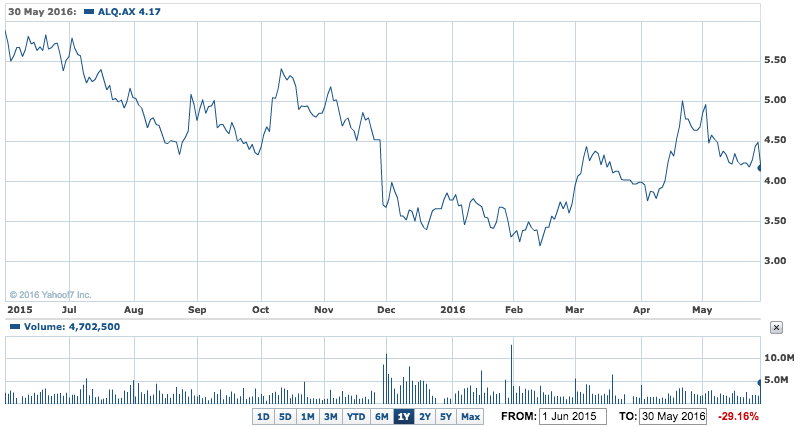Brisbane-based testing group ALS Ltd (ALQ) saw its shares hammered more than 11% lower yesterday as investors gave the full year results and weak outlook the thumbs down.
The shares fell more than 7% to $4.17 after hitting a low of $3.94 during trading. Shareholders who financed last year’s $325 million issue at $3.35 a share to repay bank debt as well as to fund acquisitions in the life sciences sector, remain well ahead, despite yesterday’s sell off.
That’s despite the company continuing with a (reduced) dividend payout for the half and full years.
There was no sales and profit forecast provided in the outlook and there was a very strong hint of further losses and possible write-downs to come with the company warning that the energy business is being examined to cut costs and bring it to break-even by the end of September (which is the end of the first half of the 2016-17 financial year).
After the $314 million of impairments taken in the year to March in the energy and minerals business, investors think there is more red ink in the offing, hence the sharp fall in the share price yesterday.
Directors also talked about “market share growth” in the oil and gas division which investors know means cutting margins (and any profits) to preserve business and contracts with customers. And that in turn means lower profit margins or losses.
Directors declared a final partly franked (40%) dividend for the year of 6 cents a share on the expanded share base following the entitlements issue of ordinary shares last December 2015 (2015: 10.0 cents, 25% franked).
Together with the interim dividend of 7.5 cents a share (25% franked) the total partly franked dividend for the year will be 13.5 cents a share (2015: 21.0 cents).
ALS Ltd revealed an annual loss of $240.7 million after $314 million of impairments which were announced earlier this year, mostly against its minerals and energy testing business.
Excluding one-off items, ALS’s profit was down 27% at $99.5 million, compared to the underlying profit of $135.4 million in 2014-15.
Underlying EBIT was 19.9% lower than 2014-15 thanks to ongoing volatility in the commodity and oil and gas markets that adversely impacted the results of the Minerals and Energy divisions.
Revenue from continuing operations of $1.365 billion was down 4% on the $1.422 billion recorded in 2014-15.
Revenue and operating profit in the company’s largest division, Life Sciences, reached record highs, according to management.
ALS 1Y – Mining downturn squeezes ALS

But the company’s resources businesses continued to be impacted by lower pricing and volumes and will continue to do so in 2016-17, according to yesterday’s outlook comments.
"Australian market conditions for ALS Industrial are expected to remain flat. Market share growth is the priority focus in the mining and Oil & Gas maintenance sectors. In North America, revenue growth is expected in the context of robust downstream Oil & Gas and petrochemical sectors,” directors said yesterday.
“The Industrial Division is strongly focused on business development and is well positioned to increase market share.
"The Company is confident that the quality of its platform, its operating model, and its strategic focus, will see it continue to increase its client penetration and market share despite the challenges of current conditions.
"The Company continues to pursue growth opportunities in Life Sciences; particularly in the food sector where it is evaluating a select number of high quality bolt-on acquisition targets in Europe and North America,” directors said.
ALS said it expects that the contribution from its Life Sciences business "will continue to increase at a strong pace, with revenues growing in the high single digit percentage through the next few years”.
That was after the Life Sciences Division “was successful in growing revenue in all regions as a result of consistent investment and market share growth,” according to CEO Greg Kilmister.
He said the Industrial Division “was relatively stable through the year, with the Tribology business growing strongly in line with previous years and the Australian Asset Care business being impacted by the unwinding of CAPEX projects in the resources sector partially offset by OPEX related activity in the sector remaining strong".
“ALS’s Minerals and Energy Divisions were faced with further reductions in exploration and development activity coupled with aggressive cost cutting initiatives from producers, leading to a lower overall profit margin for the Company,“ directors said.
Chairman, Nerolie Withnall said that whilst the company has made considerable progress in developing a balanced portfolio the FY2016 result reflected the ongoing commodity price uncertainty impacting a number of companies and sectors globally.
Commenting on the full year result, Mr Kilmister said that the Life Sciences Division was successful in growing revenue in all regions as a result of consistent investment and market share growth.
He indicated that the company’s Energy operations "are undergoing a critical evaluation of all components to ensure the business is matched to the current environment".
"A major element of the review is to rebase the operating model to reduce the cost base to sustainable levels. The objective is to get the Oil & Gas business to a breakeven point by September this year under current very poor market conditions. The Company expects short to mid-term market conditions to remain challenging and unpredictable until the oil price stabilises,” Mr Kilmister said.













